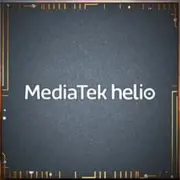MediaTek Helio G70

MediaTek Helio G70: The Budget Champion of 2025?
Overview of capabilities, performance, and use cases
Introduction
In the world of mobile processors, MediaTek has long established itself as a provider of affordable solutions. The Helio G70, released in 2020, remains popular in budget smartphones as of 2025. But how relevant is it now? Let's take a detailed look.
1. Architecture and Manufacturing Process: Basic Operating Principles
Cores and Frequencies
The Helio G70 is built on a hybrid Big.Little architecture with 8 cores:
- 2 high-performance Cortex-A75 cores clocked up to 2 GHz for resource-intensive tasks.
- 6 energy-efficient Cortex-A55 cores clocked at 1.7 GHz for background processes.
The 320 KB L2 cache speeds up data processing, but compared to modern chips (like the Cortex-A78 in Snapdragon 7 Gen 3), this is insufficient for complex computations.
12 nm Manufacturing Process
The 12-nanometer manufacturing process used in the Helio G70 seems archaic today. Modern competitors (e.g., Snapdragon 4 Gen 3) have moved to 6 nm, enhancing energy efficiency and reducing heat. However, for basic tasks, 12 nm still delivers stability.
Mali-G52 MP2 Graphics
The Mali-G52 MP2 GPU, featuring two compute units, supports:
- Resolution up to Full HD+ (1080 × 2520 pixels).
- API Vulkan 1.1 and OpenGL ES 3.2 for mobile gaming.
- Frequencies up to 820 MHz.
This is insufficient for games like Genshin Impact, but it works well for PUBG Mobile or Mobile Legends on medium settings.
2. Real-World Performance: What Can the Helio G70 Do?
Gaming
- PUBG Mobile: Medium settings (HD + 30 FPS) without lag.
- Call of Duty: Mobile: Low/medium settings (40-45 FPS).
- Genshin Impact: Only low settings with frequent drops to 20-25 FPS.
Important: Smartphones with active cooling (e.g., Xiaomi Redmi Note 10) show better stability.
Multimedia
- Video decoding: 4K@30fps (H.264/HEVC).
- Video recording: Up to 1080p@60fps.
- Display support: Full HD+ with a 60 Hz refresh rate.
AI Applications
There is no built-in neural processor (APU). Basic tasks (like background blur in the camera) are executed through CPU/GPU, slowing speed and accuracy. In comparison, Snapdragon 680 utilizes Hexagon 686, accelerating AI operations by 30-40%.
Power Consumption and Heat
With a TDP of 5 watts, smartphones with a 5000 mAh battery can last 1.5-2 days with moderate use. However, under load (gaming, video recording), the chip heats up to 42-45°C, necessitating passive cooling.
3. Integrated Modules: Connectivity and Navigation
4G LTE Modem
- Download speed: Up to 300 Mbps.
- Support for VoLTE, ViLTE.
Wi-Fi and Bluetooth
- Wi-Fi 5 (802.11ac) supporting 2.4/5 GHz ranges.
- Bluetooth 5.0 (A2DP, LE).
Navigation
- GPS, GLONASS, Galileo — a standard set for budget devices.
- A-GPS accelerates location determination in urban settings.
Cons: The lack of 5G and Wi-Fi 6 makes the Helio G70 less relevant in 2025, especially in regions with developed next-generation networks.
4. Comparison with Competitors: Who is Stronger?
MediaTek Helio G70 vs Qualcomm Snapdragon 680
- CPU Performance: Snapdragon 680 (Geekbench 6: Single-Core 450, Multi-Core 1400) is 5-7% faster.
- Graphics: The Adreno 610 in SD 680 is better optimized for gaming.
- Energy Efficiency: The 6 nm process of SD 680 is more economical.
MediaTek Helio G70 vs Unisoc Tiger T610
- AnTuTu 10: Tiger T610 scores around 220,000 points, falling short of Helio G70.
- Camera Support: Both chips work with sensors up to 48 MP, but the Tiger T610 has poorer dynamic range.
Conclusion: Helio G70 is a sweet spot among budget SoCs, but the lack of 5G and outdated manufacturing process reduce its competitiveness.
5. Use Cases: What is the Helio G70 Suitable For?
Gaming
- Recommended for casual games (Candy Crush, Among Us) and competitive titles on low settings.
Daily Tasks
- Social media, messaging, web surfing, streaming video (Netflix, YouTube) — no problems.
Photo and Video
- Main camera: Up to 48 MP with EIS support.
- Video recording: 1080p@60fps.
- Night mode: Works, but with noise and long processing times.
Tip: Choose smartphones with additional cameras (like ultra-wide) to offset the chip’s limitations.
6. Pros and Cons: Is it Worth It?
Advantages:
- Low cost of devices ($150-250).
- Energy efficiency for basic tasks.
- Support for Full HD+ displays.
Disadvantages:
- No 5G and Wi-Fi 6.
- Weak AI features.
- Heating during prolonged loads.
7. Practical Tips: How to Choose a Smartphone with Helio G70?
1. RAM and Storage: At least 4 GB of RAM + 64 GB of storage (better 6/128 GB).
2. Cooling: Models with copper pipes or graphite coatings (e.g., Realme 8i).
3. Screen: IPS with a 60 Hz refresh rate — optimal. AMOLED is rarely found.
4. Battery: At least 5000 mAh for long operation.
5. Updates: Android 13/14 with a promise of 2 years of updates.
Examples of 2025 Devices:
- Xiaomi Redmi 12C: $160, 4/64 GB, 50 MP camera.
- Realme C55: $180, 6/128 GB, 33W fast charging.
8. Final Conclusion: Who is Helio G70 Suitable For?
Target Audience:
- Users who prioritize price over top-tier performance.
- Those not willing to pay for 5G.
- Fans of compact smartphones with long battery life.
Key Benefits:
- Availability.
- Stability in everyday tasks.
- Compatibility with most applications in 2025.
Alternatives: If your budget permits, consider devices with Snapdragon 4 Gen 3 ($200-250) or MediaTek Dimensity 6100+ (5G, $250-300).
Conclusion
The MediaTek Helio G70 in 2025 is an option for those looking for a reliable workhorse without frills. It won't impress with speed, but it offers reliability and savings. However, if you plan to use the smartphone for 3-4 years, it's wise to look at more modern chips with support for 5G and AI accelerators.
Basic
GPU Specifications
Connectivity
Memory Specifications
Miscellaneous
Benchmarks
Compared to Other SoC
Share in social media
Or Link To Us
<a href="https://cputronic.com/index.php/soc/mediatek-helio-g70" target="_blank">MediaTek Helio G70</a>